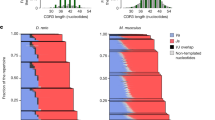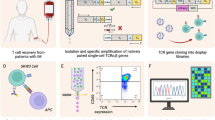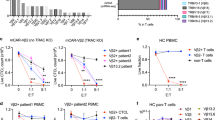Abstract
The immune system of higher organisms is composed largely of two distinct cell types, B lymphocytes and T lymphocytes, each of which is independently capable of recognizing an enormous number of distinct entities through their antigen receptors; surface immunoglobulin in the case of the former, and the T-cell receptor (TCR) in the case of the latter. In both cell types, the genes encoding the antigen receptors consist of multiple gene segments which recombine during maturation to produce many possible peptides1–9. One striking difference between B- and T-cell recognition that has not yet been resolved by the structural data is the fact that T cells generally require a major histocompatibility determinant together with an antigen10,11 whereas, in most cases, antibodies recognize antigen alone. Recently, we and others have found that a series of TCR Vβ gene sequences12,13 show conservation of many of the same residues that are conserved between heavy- and light-chain immunoglobulin V regions, and these Vβ sequences are predicted to have an immunoglobulin-like secondary structure12,13. To extend these studies, we have isolated and sequenced eight additional α-chain complementary cDNA clones and compared them with published14–16 sequences. Analyses of these sequences, reported here, indicate that Vα regions have many of the characteristics of Vβ gene segments but differ in that they almost always occur as cross-hybridizing gene families. We conclude that there may be very different selective pressures operating on Vα and Vβ sequences and that the Vα repertoire may be considerably larger than that of Vβ.
This is a preview of subscription content, access via your institution
Access options
Subscribe to this journal
Receive 51 print issues and online access
$199.00 per year
only $3.90 per issue
Buy this article
- Purchase on SpringerLink
- Instant access to full article PDF
Prices may be subject to local taxes which are calculated during checkout
Similar content being viewed by others
References
Tonegawa, S. Nature 302, 578–581 (1983).
Chien, Y., Gascoigne, N. R. J., Kavaler, J., Lee, N. E. & Davis, M. M. Nature 309, 322–326 (1984).
Siu, G. et al. Cell 37, 393–401 (1984).
Gascoigne, N. R. J., Chien, Y., Becker, D. M., Kavaler, J. & Davis, M. M. Nature 310, 387–391 (1984).
Malissen, M. et al. Cell 37, 1101–1110 (1984).
Kavaler, J., Davis, M. M. & Chien, Y. Nature 310, 421–423 (1984).
Siu, G. et al. Nature 311, 344–349 (1984).
Clark, S. P. et al. Nature 311, 387–389 (1984).
Hayday, A. C. et al. Nature 316, 828–832 (1985).
Zinkernagel, R. M. & Doherty, T. C. Nature 248, 701–702 (1974).
Shearer, G. M. Eur. J. Immun. 4, 527–533 (1974).
Patten, P. et al. Nature 312, 40–46 (1984).
Barth, R. K. et al. Nature 316, 517–523 (1985).
Chien, Y. et al. Nature 312, 31–35 (1984).
Saito, H. et al. Nature 312, 36–40 (1984).
Sim, G. K. et al. Nature 312, 771–774 (1984).
Maxam, A. & Gilbert, W. Meth. Enzym. 65, 499–560 (1980).
Clayberger, C., Dekruyff, R. H., Aisenberg, J. & Cantor, H. J. J. exp. Med. 157, 1906–1919 (1983).
Giedlin, M., Longenecker, B. & Mosmann, T. Cell. Immun. (in the press).
Samelson, L. E., Germain, R. N. & Schwartz, R. H. Proc. natn. Acad. Sci. U.S.A. 80, 6972–6976 (1983).
Waters, S. J., Winchester, R. J., Nagase, F., Thorbecke, G. J. & Bona, C. A. Proc. natn. Acad. Sci. U.S.A. 81, 7559–7563 (1984).
Kaufmann, Y., Berke, G. & Eshhar, Z. Proc. natn. Acad. Sci. U.S.A. 78, 2502–2506 (1981).
Max, E. E., Seidman, J. G., Miller, H. & Leder, P. Cell 21, 793–799 (1980).
Lewis, S., Gifford, A. & Baltimore, D. Science 228, 677–685 (1985).
Jones, N. et al. Science 227, 331–334 (1985).
Kabat, E. A., Wu, T. T., Bilofsky, H., Reid-Miller, M. & Perry, H. Sequences of Immunological Interest (US Dept Health and Human Services, Washington, DC, 1983).
Hayday, A. C. et al. Cell 40, 259–269 (1985).
Hedrick, S. M. et al. Proc. natn. Acad. Sci. U.S.A. 82, 531–535 (1985).
Croce, C. M. et al. Science 227, 1044 (1985).
Yanagi, Y., Han, A., Chin, B., Minden, M. & Mak, T. W. Proc. natn. Acad. Sci. U.S.A. (in the press).
Wall, R. & Kuehl, M. A. Rev. Immun. 1, 393–422 (1983).
Novotny, J. & Haber, E. Proc. natn. Acad. Sci. U.S.A. (in the press).
Edmundson, A. B., Ely, R. R., Abola, E. E., Schiffer, M. & Panagiopoulos, N. Biochemistry 18, 3953–3961 (1975).
Wu, T. T. & Kabat, E. A. J. exp. Med. 132, 922–930 (1970).
Amzel, L. M. & Poljak, R. J. A. Rev. Biochem. 48, 961–997 (1979).
Davies, D. R. & Metzger, H. A. Rev. Immun. 1, 87–117 (1983).
Sim, G. K. & Augustin, A. A. Cell 39, 5–12 (1984).
Saito, H. et al. Nature 309, 757–761 (1984).
Seidman, J. G., Leder, P., Nau, M., Naiman, B. & Leder, P. Science 202, 11–15 (1978).
Cory, S., Tyler, B. M. & Adams, J. M. J. molec. appl. Genet. 1, 102–116 (1981).
Brodeur, P. H. & Riblet, R. Eur. J. Immun. 14, 922–930 (1984).
Bentley, D. et al. Cell 24, 613–623 (1981).
Okayama, H. & Berg, P. Molec. Cell. Biol. 2, 161–170 (1982).
Huynh, T. V., Young, R. A. & Davis, R. W. in DNA Cloning Techniques: A Practical Approach (ed. Glover, D. M.) (IRL Press, Oxford, 1984).
Hedrick, S. M., Nielsen, E. A., Kavaler, J., Cohen, D. I. & Davis, M. M. Nature 308, 153–158 (1984).
Yanagi, Y. et al. Nature 308, 145–149 (1984).
Yoshikai, Y. et al. Nature 312, 521–525 (1984).
Litman, G. et al. Nucleic Acids Res. 10, 3371–3380 (1982).
Arden, B., Klotz, J. L., Sui, G. & Hood, L. E. Nature 316, 783–787 (1985).
Author information
Authors and Affiliations
Rights and permissions
About this article
Cite this article
Becker, D., Patten, P., Chien, Yh. et al. Variability and repertoire size of T-cell receptor Vα gene segments. Nature 317, 430–434 (1985). https://doi.org/10.1038/317430a0
Received:
Accepted:
Issue date:
DOI: https://doi.org/10.1038/317430a0
This article is cited by
-
Characterization of the mouseTcra-V22 gene subfamily
Immunogenetics (1996)
-
Locus-specific somatic hypermutation in germinal centre T cells
Nature (1994)
-
Subgroups of Tcr ? chains and correlation with T-cell function
Immunogenetics (1992)
-
A new mouse T-cell receptorα chain variable region family
Immunogenetics (1991)
-
T-Cell receptor and autoimmune disease
Immunologic Research (1990)



